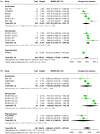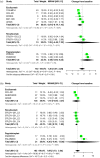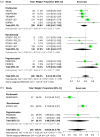Efficacy of complement inhibitors for patients with paroxysmal nocturnal hemoglobinuria: a systematic review and meta-analysis
- PMID: 38105771
- PMCID: PMC10725119
- DOI: 10.1177/20406207231216080
Efficacy of complement inhibitors for patients with paroxysmal nocturnal hemoglobinuria: a systematic review and meta-analysis
Abstract
Background: Paroxysmal nocturnal hemoglobinuria (PNH) is a rare acquired hematological disease. The development of complement inhibitors such as eculizumab, ravulizumab, and pegcetacoplan has revolutionized the management of PNH, leading to improvements in overall survival and quality of life for patients.
Objectives: This systematic review aims to provide comprehensive evidence of the efficacy of complement inhibitors in relation to treatment duration.
Design: This is a systematic review and meta-analysis.
Data sources and methods: A thorough literature search was conducted in MEDLINE, EMBASE, and the Cochrane Library up to 3 May 2022. We included all prospective interventional studies including single-arm trials. The primary outcomes of interest were lactate dehydrogenase (LDH) levels, hemoglobin (Hb) concentrations, transfusion avoidance, and Functional Assessment of Chronic Illness Therapy Fatigue (FACIT-F) scores.
Results: Our study included a total of 27 studies, comprising 5 randomized controlled trials and 11 single-arm trials, with a total of 912 patients with PNH. We stratified the studies according to treatment duration, based on the most frequently reported period of 26 weeks. Our analysis showed that treatment-naïve patients who received complement inhibitors had a pooled estimate of a decrease in LDH levels from baseline by -1462.0 U/L (95% CI: -1735.6 to -1188.5) for treatment ⩽26 weeks and -1696.5 U/L (95% CI: -2122.7 to -1270.2) for treatment >26 weeks. The mean Hb levels were increased by 1.4 g/dL (95% CI: 0.5-2.3) and 1.9 g/dL (95% CI: 0.7-3.1) in each group. Treatment with any complement inhibitor prevented the need for transfusion in at least 50% of patients with PNH in all treatment periods. Clinically meaningful improvements in FACIT-F were observed both before and after 26 weeks, with a pooled estimate of 6.8 (95% CI: 6.0-7.6) and 9.5 (95% CI: 7.0-12.0), respectively.
Conclusion: Our findings suggest that complement inhibitors can result in positive treatment outcomes and sustained benefits for patients with PNH.
Keywords: clinical outcomes; complement inhibitors; eculizumab; paroxysmal nocturnal hemoglobinuria; pegcetacoplan; rare disease; ravulizumab.
© The Author(s), 2023.
Conflict of interest statement
The authors declare that there is no conflict of interest.
Figures





Similar articles
-
Predictors for improvement in patient-reported outcomes: post hoc analysis of a phase 3 randomized, open-label study of eculizumab and ravulizumab in complement inhibitor-naive patients with paroxysmal nocturnal hemoglobinuria.Ann Hematol. 2024 Jan;103(1):5-15. doi: 10.1007/s00277-023-05483-0. Epub 2023 Oct 7. Ann Hematol. 2024. PMID: 37804344 Free PMC article. Clinical Trial.
-
Comparative effectiveness of pegcetacoplan versus ravulizumab in patients with paroxysmal nocturnal hemoglobinuria previously treated with eculizumab: a matching-adjusted indirect comparison.Curr Med Res Opin. 2021 Nov;37(11):1913-1923. doi: 10.1080/03007995.2021.1971182. Epub 2021 Sep 3. Curr Med Res Opin. 2021. PMID: 34445916
-
Comparative Effectiveness of Pegcetacoplan Versus Ravulizumab and Eculizumab in Complement Inhibitor-Naïve Patients with Paroxysmal Nocturnal Hemoglobinuria: A Matching-Adjusted Indirect Comparison.Adv Ther. 2023 Apr;40(4):1571-1589. doi: 10.1007/s12325-023-02438-9. Epub 2023 Feb 7. Adv Ther. 2023. PMID: 36750531 Free PMC article.
-
Pegcetacoplan: A Review in Paroxysmal Nocturnal Haemoglobinuria.Drugs. 2022 Dec;82(18):1727-1735. doi: 10.1007/s40265-022-01809-w. Epub 2022 Dec 2. Drugs. 2022. PMID: 36459381 Free PMC article. Review.
-
Safety and efficacy of pegcetacoplan in paroxysmal nocturnal hemoglobinuria.Ther Adv Hematol. 2022 Jul 28;13:20406207221114673. doi: 10.1177/20406207221114673. eCollection 2022. Ther Adv Hematol. 2022. PMID: 35923770 Free PMC article. Review.
References
-
- Brodsky RA, Hu R. PIG-A mutations in paroxysmal nocturnal hemoglobinuria and in normal hematopoiesis. Leuk Lymphoma 2006; 47: 1215–1221. - PubMed
-
- Martí-Carvajal AJ, Anand V, Cardona AF, et al.. Eculizumab for treating patients with paroxysmal nocturnal hemoglobinuria. Cochrane Database Syst Rev 2014; 10: CD010340. - PubMed
Publication types
LinkOut - more resources
Full Text Sources

